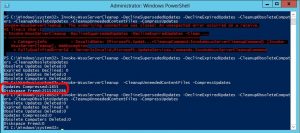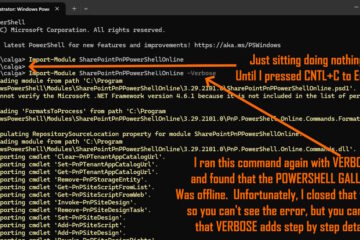If you cannot complete a clean up of your WSUS server through the WSUS console because it keeps erroring out with SERVER NODE RESET, you can hopefully complete through the following PowerShell command line:
Invoke-WsusServerCleanup -DeclineSupersededUpdates -DeclineExpiredUpdates -CleanupObsoleteComputers -CleanupObsoleteUpdates -CleanupUnneededContentFiles -CompressUpdates
If this fails or times out, you can run each of the commands one by one:
Invoke-WsusServerCleanup -CleanupUnneededContentFiles -CompressUpdates
Invoke-WsusServerCleanup -DeclineSupersededUpdates
Invoke-WsusServerCleanup -DeclineExpiredUpdates
Invoke-WsusServerCleanup -CleanupObsoleteComputers
Invoke-WsusServerCleanup -CleanupObsoleteUpdates -CompressUpdates
Whichever command you finish on should include -CompressUpdates because that is the command which actually deletes the garbage from the database.
If you want to know what the switches are for INVOKE-WSUSSERVERCLEANUP, skim through THIS Microsoft article.
 Note that if your WSUS database is corrupted or has other issues, you will want to run WSUS Database cleanup as we describe HERE.
Note that if your WSUS database is corrupted or has other issues, you will want to run WSUS Database cleanup as we describe HERE.
There are a few notes to this script:
- You need to run POWERSHELL as an Admin
. - If you see the following error go to your SERVICES and start WSUS Certificate Server or just type NET START WSusCertServer
Invoke-WsusServerCleanup : The service cannot be started, either because it is disabled or because it has no enabled devices associated with it
. - As you can see in the screen shot my first round at this failed. I also had .NET error the appeared which I mistakenly cleared before reading carefully. Then I shortened up the script to do less:
Invoke-WsusServerCleanup -CleanupUnneededContentFiles -CompressUpdates
Then I ran the other half of the script:
Invoke-WsusServerCleanup -DeclineSupersededUpdates -DeclineExpiredUpdates -CleanupObsoleteComputers -CleanupObsoleteUpdates
Then I ran the entire script again, which apparently did nothing. After that I was able to the WSUS SERVER CLEAN UP WIZARD from the WSUS console without problem.
.




11 Comments
Kevin · June 25, 2022 at 2:54 am
This got me out of the dreaded ‘Server node reset’ errors. Thank you!
Wolf · August 24, 2023 at 2:34 am
worked like a charm (Win2019). Thanks
Tiago Feigo · November 11, 2020 at 1:51 pm
Hello, does this solution apply to WinSer2019? because I tried 3 times and this error occurs in PowerShell.
Invoke-WsusServerCleanup: Execution Timeout Expired. The timeout period ended before completion
operation or the server is not responding.
The instruction has ended.
In line: 1 character: 18
+ … susServer | Invoke-WsusServerCleanup -DeclineSupersededUpdates -Decli …
+ ~~~~~~~~~~~~~~~~~~~~~~~~~~~~~~~~~~~~~~~~~~~~~~~~~~~~~~~~~~~~~~~~~~ ~~~~~~~~
+ CategoryInfo: InvalidData: (Microsoft.Updat … rCleanupCommand: InvokeWsusServerCleanupCommand) [Invoke-
WsusServerCleanup], SqlException
+ FullyQualifiedErrorId: UnexpectedError, Microsoft.UpdateServices.Commands.InvokeWsusServerCleanupCommand
Ian Matthews · November 14, 2020 at 3:56 pm
Hi Tiago;
I do not have a Server 2019 box but I doubt it is different as WSUS has not changed from version 3 in years. I no longer have access to a WSUS box as several of my customers just shut down due to COVID and world oil prices; the next time I expect to have my hands on one is in December and that is likely too late to assist.
Wirelessnutt · December 8, 2017 at 11:59 am
Is there a version of this that works with Powershell Version 2? Installing any newer version of Powershell on SBS 2011 or earlier will break things – badly.
Ian Matthews · December 28, 2017 at 11:12 am
I am sorry to say we are only aware of the PS code requiring the latest PowerShell 🙁
Stephen Hogan · July 6, 2017 at 1:54 am
Hi,
The screenshot shows the reverse of what you state in step 3, i.e.:
First you ran:
Invoke-WsusServerCleanup -DeclineSupersededUpdates -DeclineExpiredUpdates -CleanupObsoleteComputers -CleanupObsoleteUpdates
Then you ran:
Invoke-WsusServerCleanup -CleanupUnneededContentFiles -CompressUpdates
And then you ran the whole script.
Just clarifying….
Thanks, in advance.
Stephen
srekcuS · May 16, 2017 at 2:25 am
Hey,
I just stumbled across this post and it looks fantastic.
I have a 2008R2 server with WSUS and powershell 4.0 on it. When I try to run the ‘Invoke-WsusServerCleanup’ command I get this error:
The term ‘Invoke-WsusServerCleanup’ is not recongized as the name of a cmdlet, function, script file…
Can you point me in the right direction?
Thanks
Ian Matthews · May 24, 2017 at 5:12 pm
Two things come to mind. 1: Are you running PowerShell as an Admin (not just logged into Windows as an Admin, but running the PowerShell app as an Admin) 2: See if you can access any WSUS PowerShell commands like: Get-WSUSServer | fl *
Kevin Lawrence · September 26, 2017 at 5:09 am
I am also running 08 r2, running as admin, and the commands don’t work for me either.
Ian Matthews · December 28, 2017 at 11:30 am
Hi Kevin;
Are you running the a current version of PowerShell? These commands require the updated PS builds.